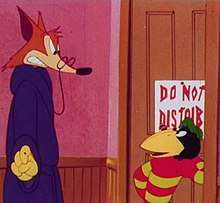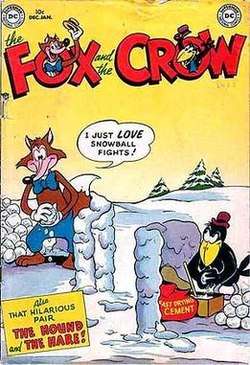The Fox and the Crow
The Fox and the Crow are a pair of anthropomorphic cartoon characters created by Frank Tashlin for the Screen Gems studio.[1]
| Fox and Crow | |
|---|---|
 | |
| First appearance | The Fox and the Grapes, December 5, 1941 |
| Last appearance | Punchy de Leon, January 12, 1950 |
| Created by | Frank Tashlin |
| Voiced by | Mel Blanc (1941, Both) Frank Graham (1942–1949, Fauntleroy and Crawford) John T. Smith (1948–1949, Fauntleroy and Crawford) Daws Butler (1950, Both) |
| In-universe information | |
| Gender | Male |
The characters, the refined but gullible Fauntleroy Fox and the streetwise Crawford Crow, appeared in a series of animated short subjects released by Screen Gems through its parent company, Columbia Pictures.[2][3]
Columbia cartoons
Tashlin directed the first film in the series, the 1941 Color Rhapsody short The Fox and the Grapes, based on the Aesop fable of that name. Warner Bros. animation director Chuck Jones later acknowledged this short, which features a series of blackout gags as the Fox repeatedly tries and fails to obtain a bunch of grapes in the possession of the Crow, as one of the inspirations for his popular Road Runner cartoons.[4]
Although Tashlin directed no more films in the series, Screen Gems continued producing Fox and the Crow shorts, many of them directed by Bob Wickersham, until the studio closed in 1946.[5] Screen Gems had acquired enough of a backlog of completed films that the "Fox and Crow" series continued through 1949.
By this time, Columbia had signed a distribution deal with a new animation studio, United Productions of America (UPA), to produce three "Fox and the Crow" shorts, Robin Hoodlum (1948), The Magic Fluke (1949), and Punchy DeLeon (1950). All three UPA Fox and the Crow cartoons were directed by John Hubley. The first two each received an Academy Award nomination for Animated Short Subject.
An unrelated, six-minute, silent animated short titled The Fox and the Crow, produced by Fables Studio, was released in 1921.[6]
List of shorts
Screen Gems
1941
Note: Fox and Grapes (1941) are a part of the Color Rhapsodies and not the Fox and the Crow series until 1943 and the first appearance of the Fox and the Crow in Cartoons.
| Film | Original release date |
|---|---|
| Fox and Grapes | December 5, 1941 |
1942
Note: Woodman, Spare That Tree (1942) and TollBridge Troubles (1942) are a part of the Color Rhapsodies and not the Fox and the Crow series until 1943.
| Film | Original release date |
|---|---|
| Woodman, Spare That Tree | July 2, 1942 |
| TollBridge Troubles | November 27, 1942 |
1943
Note: Until 30 September of 1943, the cartoons: Slay It With Flowers (1943), Plenty Below Zero (1943), Tree for Two (1943) and A-Hunting We Won't Go (1943) are a part of the Color Rhapsodies and not the Fox and the Crow series. In 30 Sepetmber of 1943 release of the first cartoon of the Fox and the Crow series Room and Bored.
| Film | Original release date |
|---|---|
| Slay It With Flowers | January 29, 1943 |
| Plenty Below Zero | April 23, 1943 |
| Tree for Two | June 21, 1943 |
| A-Hunting We Won't Go | August 23, 1943 |
| Room and Bored | September 30, 1943 |
| Way Down Yonder in the Corn | November 25, 1943 |
1944
| Film | Original release date |
|---|---|
| The Dreams Kids | April 28, 1944 |
| Mr. Moocher | September 8, 1944 |
| Be Patient, Patient | November 30, 1944 |
| The Egg-Yegg | December 8, 1944 |
1945
| Film | Original release date |
|---|---|
| Ku-Ku Nuts | July 26, 1945 |
| Treasure Jest | August 30, 1945 |
| Phoney Baloney | November 1, 1945 |
1946
Note: This year is of Last year for the Fox and the Crow Series with last three cartoons.
| Film | Original release date |
|---|---|
| Foxy Flatfoots | April 11, 1946 |
| Unsure Runts | May 16, 1946 |
| Mysto-Fox | August 29, 1946 |
1947
Note: Tooth or Consequences (1947) are a part of the Phantasy and not the Fox and the Crow series until the last Cartoon of Fox and Crow in Color Rhapsodies in 1949 Grape Nutty.
| Film | Original release date |
|---|---|
| Tooth or Consequences | June 5, 1947 |
1949
| Film | Original release date |
|---|---|
| Grape Nutty | April 14, 1949 |
UPA
1948
Note: The First Cartoon of the Fox and the Crow series made by United Productions of America (UPA) and went received an Academy Award nomination for Animated Short Subject.
| Film | Original release date |
|---|---|
| Robin Hoodlum | December 23, 1948 |
1949
Note: The Second and Final Cartoon of the Fox and the Crow series made by United Productions of America (UPA) and went received other Academy Award nomination for Animated Short Subject.
| Film | Original release date |
|---|---|
| The Magic Fluke | March 24, 1949 |
1950
Note: Punchy de Leon (1950) are a part of the Jolly Frolices and not the Fox and the Crow series and the last appearance of the Fox and the Crow in Cartoons.
| Film | Original release date |
|---|---|
| Punchy de Leon | January 12, 1950 |
In other media
Comic books
| The Fox and the Crow | |
|---|---|
 The Fox and the Crow #1 (Jan. 1952). Cover artist unknown. | |
| Publication information | |
| Publisher | DC Comics |
| Publication date | Dec. 1951/Jan. 1952 - February–March 1968 |
| No. of issues | 108 |
| Main character(s) | The Fox and the Crow Stanley and His Monster |
| Creative team | |
| Written by | Cecil Beard and Alpine Harper |
| Artist(s) | Jim Davis |
The Fox and the Crow starred in several funny animal comic books published by DC Comics, from the 1940s well into the 1960s. They starred with other characters in DC's Columbia-licensed funny animal anthology Real Screen Comics (first issue titled Real Screen Funnies) beginning in 1945,[7] then did likewise when DC converted the superhero title Comic Cavalcade to a funny-animal series in 1948.
The duo received its own title, The Fox and the Crow, which ran 108 issues (Jan. 1952 - March 1968). Until the 1954 demise of Comic Cavalcade, Fox and Crow were cover-featured on three DC titles. They continued on the cover of Real Screen Comics through its title change to TV Screen Cartoons from #129-138 (Aug. 1959 - Feb. 1961), the final issue.
The Fox and the Crow itself was renamed Stanley and His Monster beginning with #109 (May 1968), after the back-up feature, begun in #95 (Jan. 1966), that had taken over in popularity. For the last ten years of its existence, The Fox and the Crow was written by Cecil Beard, assisted by his wife, Alpine Harper. The illustrator was Jim Davis (b. 1915), although it was generally unsigned.[8]
Feature films
The Fox and the Crow were going to have a cameo in Who Framed Roger Rabbit, but were dropped for unknown reasons.[9]
See also
Footnotes
- Lenburg, Jeff (1999). The Encyclopedia of Animated Cartoons. Checkmark Books. pp. 82–83. ISBN 0-8160-3831-7. Retrieved 6 June 2020.
- "The Comic Book Price Guide For Great Britain - FOX AND THE CROW". www.comicpriceguide.co.uk.
- "1940s Columbia Screen Gems Posters |". cartoonresearch.com.
- Maltin, Leonard (1980). "Columbia: Charles Mintz and Screen Gems". Of Mice and Magic: A History of American Animated Cartoons. New American Library. p. 214. ISBN 9780452259935.
- Markstein, Don. "The Fox and the Crow". Don Markstein's Toonopedia. Retrieved 2 April 2020.
- DataBase, The Big Cartoon. "The Fox And The Crow (Fables Studios, Keith-Albee Theatres)". Big Cartoon DataBase (BCDB).
- Wallace, Daniel; Dolan, Hannah, ed. (2010). "1940s". DC Comics Year By Year A Visual Chronicle. Dorling Kindersley. p. 49. ISBN 978-0-7566-6742-9.
Animated cartoons were big business on movie screens, and lots of publishers hoped that success could translate onto the pages of comic books.... DC editor Whitney Ellsworth licensed the characters of Charles Mintz' Screen Gems Studio from their distributor, Columbia. The resulting funny animal anthology, Real Screen Comics, starred the Fox and the Crow.
CS1 maint: extra text: authors list (link) - The Fox and The Crow #97, April–May 1966 letters column
- "Who Framed Roger Rabbit?, by Jeffrey Price and Peter S. Seaman". www.dailyscript.com.
External links
- The Fox and the Crow at the Grand Comics Database
- Real Screen Funnies at the Grand Comics Database
- The Columbia Crow's Nest via The Wayback Machine
- The Fox and the Crow at Don Markstein's Toonopedia. Archived from the original on July 30, 2016.
- The Fox and Crow at the Big Cartoon DataBase